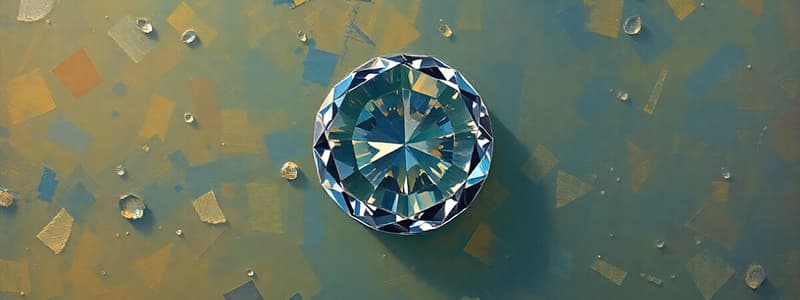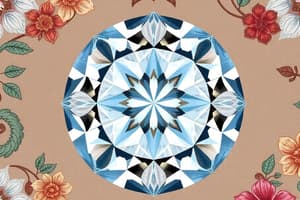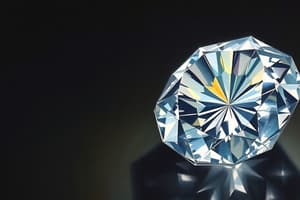Podcast
Questions and Answers
What does the term 'star angle variation' refer to in diamond craftsmanship?
What does the term 'star angle variation' refer to in diamond craftsmanship?
- Variation in the diamond’s color intensity
- Unequal star facet angles (correct)
- Inconsistency in the polishing process
- Differences in carat weight among diamonds
Which type of variation specifically measures the length percentages of the diamond’s lower half facets?
Which type of variation specifically measures the length percentages of the diamond’s lower half facets?
- Lower half percentage variation (LPV) (correct)
- Lower half variation (LHV)
- Star percentage variation (SPV)
- Upper half variation (UHV)
What is indicated by a diamond being rated as 'Excellent' for both polish and symmetry?
What is indicated by a diamond being rated as 'Excellent' for both polish and symmetry?
- The diamond has significant visible flaws
- The diamond has minor imperfections that are difficult to find (correct)
- The diamond is guaranteed to have perfect angles
- The diamond is flawless without any imperfections
Which term describes a facet that should be present but is missing from a diamond?
Which term describes a facet that should be present but is missing from a diamond?
What does the term 'non-pointing' refer to in diamond facet alignment?
What does the term 'non-pointing' refer to in diamond facet alignment?
What does 'lower half variation (LHV)' specifically measure in a diamond?
What does 'lower half variation (LHV)' specifically measure in a diamond?
Which of the following describes facets that are not properly formed or are uneven?
Which of the following describes facets that are not properly formed or are uneven?
What does a 'non-octagonal table' imply about a diamond's cut?
What does a 'non-octagonal table' imply about a diamond's cut?
What feature of a diamond can affect its polish when viewed at 10x magnification?
What feature of a diamond can affect its polish when viewed at 10x magnification?
What is the primary function of the pavilion facets in a diamond?
What is the primary function of the pavilion facets in a diamond?
Which of these variations would indicate that a diamond is not symmetrical?
Which of these variations would indicate that a diamond is not symmetrical?
What is indicated by an uneven outline of a diamond's girdle?
What is indicated by an uneven outline of a diamond's girdle?
How is the pavilion depth percentage calculated?
How is the pavilion depth percentage calculated?
What does a culet off-center condition reveal about the diamond?
What does a culet off-center condition reveal about the diamond?
What effect does a steep pavilion angle have on a diamond's appearance?
What effect does a steep pavilion angle have on a diamond's appearance?
What does the lower half length percentage represent in diamond grading?
What does the lower half length percentage represent in diamond grading?
Which factor is typically related to crown angle variation in a round brilliant cut diamond?
Which factor is typically related to crown angle variation in a round brilliant cut diamond?
What is a sign of multiple symmetry variations in a diamond?
What is a sign of multiple symmetry variations in a diamond?
How is the girdle thickness percentage defined?
How is the girdle thickness percentage defined?
Which statement best describes a laser manufacturing remnant (LMR)?
Which statement best describes a laser manufacturing remnant (LMR)?
What does a table/culet alignment issue indicate in a diamond's design?
What does a table/culet alignment issue indicate in a diamond's design?
What likely occurs with a diamond that has variations in girdle thickness?
What likely occurs with a diamond that has variations in girdle thickness?
Which factor relates directly to the appearance of a diamond's facets?
Which factor relates directly to the appearance of a diamond's facets?
What does a total depth percentage exceeding 65 percent suggest about a diamond?
What does a total depth percentage exceeding 65 percent suggest about a diamond?
Which of the following best defines 'polish' in the context of diamond quality?
Which of the following best defines 'polish' in the context of diamond quality?
What are polish lines in a diamond?
What are polish lines in a diamond?
The degree of visibility of a diamond's features when evaluated under magnification is a measure of what?
The degree of visibility of a diamond's features when evaluated under magnification is a measure of what?
What does the presence of 'abrasion' look like on a diamond?
What does the presence of 'abrasion' look like on a diamond?
Which of these would indicate poor finish quality in a diamond?
Which of these would indicate poor finish quality in a diamond?
What is 'lizard skin' in relation to diamond blemishes?
What is 'lizard skin' in relation to diamond blemishes?
How can excessive heat during polishing affect a diamond's appearance?
How can excessive heat during polishing affect a diamond's appearance?
What is a 'rough girdle' characteristic in diamonds?
What is a 'rough girdle' characteristic in diamonds?
What does good symmetry in a diamond mean?
What does good symmetry in a diamond mean?
What rating would a diamond receive if it has several small blemishes and slightly off-center facets?
What rating would a diamond receive if it has several small blemishes and slightly off-center facets?
Which of the following factors is least likely to affect a diamond’s cut grade?
Which of the following factors is least likely to affect a diamond’s cut grade?
In determining a diamond’s brightness, which combination of factors has the most impact?
In determining a diamond’s brightness, which combination of factors has the most impact?
What characteristic would likely lead to a fair rating for a diamond's finish quality?
What characteristic would likely lead to a fair rating for a diamond's finish quality?
Which factor primarily determines the lowest cut grade for a diamond?
Which factor primarily determines the lowest cut grade for a diamond?
What is the consequence of having a wavy girdle on a diamond?
What is the consequence of having a wavy girdle on a diamond?
Which statement about polish and symmetry is true for diamond ratings?
Which statement about polish and symmetry is true for diamond ratings?
Which two factors can interact negatively to affect the cut grade of a diamond?
Which two factors can interact negatively to affect the cut grade of a diamond?
What aspect should be emphasized more than numerical parameters when evaluating a diamond?
What aspect should be emphasized more than numerical parameters when evaluating a diamond?
If a diamond has numerous misshapen facets, what rating is most appropriate?
If a diamond has numerous misshapen facets, what rating is most appropriate?
Flashcards
Star Angle Variation (SV)
Star Angle Variation (SV)
Unequal angles of star facets on a diamond.
Star Percentage Variation (SPV)
Star Percentage Variation (SPV)
Uneven proportions of star facet lengths.
Upper Half Variation (UHV)
Upper Half Variation (UHV)
Facet angles in the upper half of a diamond are not consistent.
Lower Half Percentage Variation (LPV)
Lower Half Percentage Variation (LPV)
Signup and view all the flashcards
Lower Half Variation (LHV)
Lower Half Variation (LHV)
Signup and view all the flashcards
Missing Facet (MF)
Missing Facet (MF)
Signup and view all the flashcards
Misalignment (Aln)
Misalignment (Aln)
Signup and view all the flashcards
Non-pointing (Ptg)
Non-pointing (Ptg)
Signup and view all the flashcards
Polish mark
Polish mark
Signup and view all the flashcards
Laser manufacturing remnant (LMR)
Laser manufacturing remnant (LMR)
Signup and view all the flashcards
Diamond symmetry
Diamond symmetry
Signup and view all the flashcards
Out-of-Round (OR)
Out-of-Round (OR)
Signup and view all the flashcards
Table off-center (T/oc)
Table off-center (T/oc)
Signup and view all the flashcards
Culet off-center (C/oc)
Culet off-center (C/oc)
Signup and view all the flashcards
Table/Culet alignment (T/C)
Table/Culet alignment (T/C)
Signup and view all the flashcards
Girdle thickness variation (GTV)
Girdle thickness variation (GTV)
Signup and view all the flashcards
Crown angle variation (CV)
Crown angle variation (CV)
Signup and view all the flashcards
Pavilion angle variation (PV)
Pavilion angle variation (PV)
Signup and view all the flashcards
Pavilion Depth Percentage
Pavilion Depth Percentage
Signup and view all the flashcards
Pavilion Angle
Pavilion Angle
Signup and view all the flashcards
Girdle Thickness Percentage
Girdle Thickness Percentage
Signup and view all the flashcards
Lower Half Length Percentage
Lower Half Length Percentage
Signup and view all the flashcards
Culet Size
Culet Size
Signup and view all the flashcards
Weight Ratio
Weight Ratio
Signup and view all the flashcards
Depth Percentage
Depth Percentage
Signup and view all the flashcards
Polish
Polish
Signup and view all the flashcards
Symmetry
Symmetry
Signup and view all the flashcards
Abrasion (Abr)
Abrasion (Abr)
Signup and view all the flashcards
Lizard Skin (LS)
Lizard Skin (LS)
Signup and view all the flashcards
Nick (Nck)
Nick (Nck)
Signup and view all the flashcards
Pit (Pit)
Pit (Pit)
Signup and view all the flashcards
Polish Lines (PL)
Polish Lines (PL)
Signup and view all the flashcards
Rough Girdle (RG)
Rough Girdle (RG)
Signup and view all the flashcards
Diamond Cut Grade
Diamond Cut Grade
Signup and view all the flashcards
Good Cut
Good Cut
Signup and view all the flashcards
Fair Cut
Fair Cut
Signup and view all the flashcards
Poor Cut
Poor Cut
Signup and view all the flashcards
What factors determine a diamond's cut grade?
What factors determine a diamond's cut grade?
Signup and view all the flashcards
Most Important Cut Factors
Most Important Cut Factors
Signup and view all the flashcards
Cut Grade Interaction
Cut Grade Interaction
Signup and view all the flashcards
Cut Grade vs. Actual Appearance
Cut Grade vs. Actual Appearance
Signup and view all the flashcards
Transparency
Transparency
Signup and view all the flashcards
Study Notes
Diamond Grading Proportions - Pavilion, Culet, and Finish
-
Pavilion: Diamond's pavilion facets reflect light from above back towards the crown, creating brightness and fire. Pavilion depth percentage measures the distance from the girdle to the culet as a percentage of the average girdle diameter. The pavilion angle is where the pavilion mains meet the girdle.
-
Estimating Pavilion Depth Percentage: Generally accurate for grading and appraisal. Identifying reflections from facets through the table can estimate the pavilion depth percentage. Variations in facet alignment affect reflected patterns.
-
Pavilion Depth Percentage & Angles: Steeper angles create darker areas under the table; shallower angles plus a large table can create unattractive reflections (e.g., fisheye effect). Higher pavilion depth percentage generally correlates with steeper angles.
-
Girdle, Lower Half Facets, and Culet:
-
Girdle Thickness Percentage: The girdle's thickness as a percentage of the average girdle diameter. This measurement is important for evaluating the diamond's cut grade.
-
Lower Half Facet Length Percentage: The length of the lower half facets in relation to the total distance to the culet (measured at 100%), evaluating for proper proportions.
-
Culet Size: The culet facet at the bottom of the diamond where the pavilion meets the girdle. A pointed culet and its size are important for evaluating the cut grade. Imperfections at the culet, such as chips, reduce the estimate of pavilion depth percentage.
-
-
Calculations: Girdle thickness percentage is calculated by subtracting crown height and pavilion depth from total depth and rounding to 0.5%.
-
Cut Quality: Limitations of the pavilion's and the other facets affect the diamond's possible cut grade.
Design and Craftsmanship
-
Design: The diamond's physical shape including its proportions, durability, and weight.
-
Craftsmanship: The level of care that goes into the diamond's finishing details, and the overall polish and symmetry. Craftsmanship is important in determining aesthetic value.
Finish (Polish and Symmetry)
-
Polish: The overall condition of the diamond's facet surfaces. A well-polished diamond reflects light sharply and transmits it clearly. Imperfections, like abrasions and scratches, affect a diamond's polish rating.
-
Symmetry: Refers to exactness of diamond facet shape and placement. Assessments are based on its appearance when looking at it under magnification. Discrepancies in shape affect a diamond's symmetry rating.
Symmetry
- Facet Alignment: Round brilliants have 58 perfectly shaped facets. Variations in placement of facets are common and usually don't significantly impact appearance.
- Out of Round (OR), Table Offset (T/oc), Culet Offset (C/oc), Table/Culet Alignment (T/C): Girdle, table, and culet are not perfectly centered.
- Girdle Thickness Variation, Crown Angle Variation (CV), Pavilion Angle Variation (PV): Variations in the measurements of crown and pavilion angles.
- Crown Height Variation (CHV), Pavilion Depth Variation (PDV): Variations in the diamond's crown and pavilion depth measurements.
- Star Angle Variation (SV), Star Percentage Variation (SPV), Upper Half Variation (UHV), Lower Half Variation (LHV): Variations among star and lower/upper half facet angles/lengths.
- Missing Facet (MF), Extra Facets (EF), Natural (N): Facets that aren't standard according to the cut type and irregularities, respectively.
- Non-Octagonal Table (T/oct): Deviation from the ideal eight-sided table shape.
- Misshapen Facets: Facets that are not the correct size and shape.
- Non-Pointing (Ptg): Facets that do not meet precisely at points.
Rating Polish and Symmetry
- Excellent (Ex), Very Good (VG), Good (G), Fair (F), Poor (P): Specific gradings used for polish and symmetry. Excellent indicates high quality; Poor indicates significant issues.
Putting It All Together
- The combination of all factors measured for Polish, Symmetry, and Design and Craftsmanship determine the final cut grade. The lowest score for any category in an assessment usually determines the final grade.
- Factors like table percentage, crown angle, and pavilion angle are important for evaluating a round brilliant diamond's brightness.
Studying That Suits You
Use AI to generate personalized quizzes and flashcards to suit your learning preferences.
Related Documents
Description
Test your knowledge on diamond grading proportions, focusing on the pavilion, culet, and finish. Understand how the pavilion depth percentage and angles affect the diamond's brilliance and overall appearance. This quiz will cover essential concepts in grading and appraisal.




